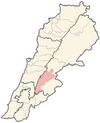|
Aitanite
HistoryIn 1838, missionary and scholar Eli Smith noted 'Aithenit as a village on the West side of the Beqaa Valley, next to Bab Mari'a.[1] Aitanit has approximately 880 residents. In the municipal Lebanese elections of 2004, its accounted 3,263 registered voters of which 1,784 actual voters. If the total number of Aitanite citizens who have emigrated were included the figure would be nearer to 20,000. Aitanite is a popular summer destination for many Lebanese living abroad whose families originated from this area. Many former Aitaneet families live in Cleveland, Michigan, Ottawa, and Montreal. Many people return in the summer to visit friends and family members. Currently, many of the townspeople are elderly or children because other locals reside in the capital region of Beirut, or elsewhere for job/business opportunities. Aitanit has two churches serving the village, one for the Maronites and the other is Melkite Catholic. The village is predominantly Catholic but is surrounded by the neighboring Muslim town of Machghara and Christian villages of Bab Mareh, Saghbine, and Ain Zebde. Aitanit has one school taught by the nuns of the village. Aitanit is about (45 km) 45 minutes from Zahlé (Capital of the Bekaa valley region) and about an hour and thirty minutes from Beirut. In the winter, Aitanit experiences cool, wet, snowy conditions (about 10/50 degrees in the day and about 1/33 or 1/34 degrees in the night) but in the summer, it experiences hot dry conditions (30/86 to 37/99 in the day and about 20/68 to 28/82 in the night). Each year, Aitanit holds a festival called Eid Al Sayde. At the festival, you can experience food cooked by the women of the town, fireworks and loud dabke music. Dabke is a traditional Lebanese dance. Climate
References
Bibliography External links
|
||||||||||||||||||||||||||||||||||||||||||||||||||||||||||||||||||||||||||||||||||||||||||||||||||||||||

